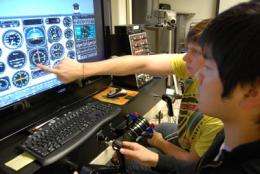Research may change course of flight instructor training

(PhysOrg.com) -- A new aviation training device in use at Arizona State University may help researchers develop rigorous new methods of training for both civilian and military instructor pilots.
The Air Force Research Laboratory, adjacent to ASU's Polytechnic campus, combined two single-control Personal Computer Aviation Training Devices (PCATD) and installed the resulting dual-control PCATD in a lab at the Polytechnic campus to study and improve flight training and instruction.
“There has been very little change in aviation instructor training over the last 50 to 60 years,” said ASU alumna Patricia Fitzgerald, a research psychologist with the Air Force team. “It has traditionally been more of an art than a science. What we want to do is produce a set of validated instructional methods that can be made available to aviation schools, instructors and instructor candidates.”
Commercially available dual-control flight training devices and simulators are very costly. Fitzgerald says that the modified PCATD is more affordable than commercial versions and students are already familiar with the single-control model.
The dual-control device consists of two desktop aircraft controls linked together to emulate the layout of a real cockpit. Students enrolled in instrumentation training as well as instructor training courses work side-by-side on the same simulator. Their training sessions are recorded and critiqued by expert instructors.
Using the dual-control device, the instructor candidate can interact with the student as he or she would in flight, rather than simply observing a student operating the single control model. For instance, instructor candidates can demonstrate how a maneuver is performed or reduce the student’s workload to allow the student to focus on a specific task.
In flight, instructors must be able to multitask - simultaneously instructing, observing, and remaining ready to take the controls at a moment’s notice. The dual-control simulator allows instructor candidates to practice those skills and expert instructors, to offer more relevant critiques.
Jim Anderson, a faculty member in the College of Technology and Innovation who is using the new device to help teach aviation students, said that the new device gives students one other very important advantage.
“Instructors fly from a different seat using opposite controls,” Anderson said. “From the pilot’s seat, you work the throttle with your right hand and the yoke control with your left; from the instructor’s seat, your hand positions are reversed. It might not seem like a big difference, but instructors in training have to learn to fly in a new way. They can’t gain that experience using our standard simulators.”
Anderson expects the dual-control simulator to improve instructor candidates’ skills before they are ever expected to take the instructor’s seat in an aircraft.
According to Dee Andrews, senior scientist and expert in training instruction with the Air Force Research Laboratory, the researchers hope to extend their study of student instructor techniques into behavior during flight instruction, as well as possibly conducting studies on the long-term outcomes of training programs.
“We’re hoping to identify strategies that can be used in commercial pilot training and, eventually, to apply those strategies to training instructor pilots for the Air Force,” Andrews said.
Provided by Arizona State University


















